Report: Critical Appraisal of an RCT Research Tool Analysis
VerifiedAdded on 2022/10/18
|7
|1664
|14
Report
AI Summary
This report provides a critical appraisal of a randomized controlled trial (RCT) research tool, specifically evaluating a study on nutrition intervention for pressure ulcer healing. The analysis examines key aspects of the RCT methodology, including randomization, allocation concealment, and blinding, to assess its validity and reliability. The report identifies both strengths, such as similar treatment groups at baseline and intention-to-treat analysis, and weaknesses, particularly the lack of blinding and allocation concealment. The author suggests improvements to enhance the effectiveness of the RCT, emphasizing the importance of these elements. The conclusion summarizes the findings, highlighting the impact of methodological choices on the study's overall credibility and providing recommendations for future research. The report references relevant literature to support its analysis.
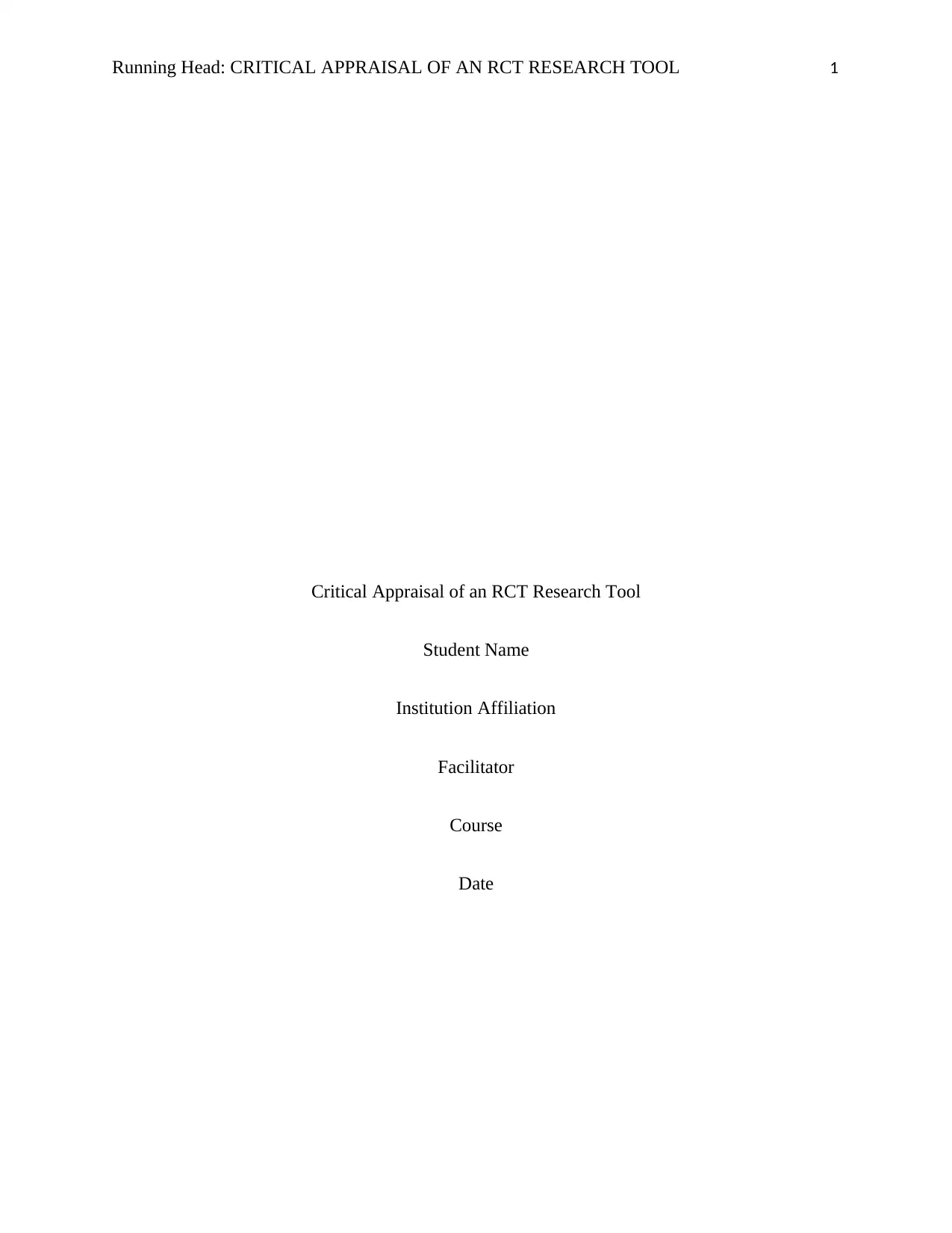
Running Head: CRITICAL APPRAISAL OF AN RCT RESEARCH TOOL 1
Critical Appraisal of an RCT Research Tool
Student Name
Institution Affiliation
Facilitator
Course
Date
Critical Appraisal of an RCT Research Tool
Student Name
Institution Affiliation
Facilitator
Course
Date
Paraphrase This Document
Need a fresh take? Get an instant paraphrase of this document with our AI Paraphraser
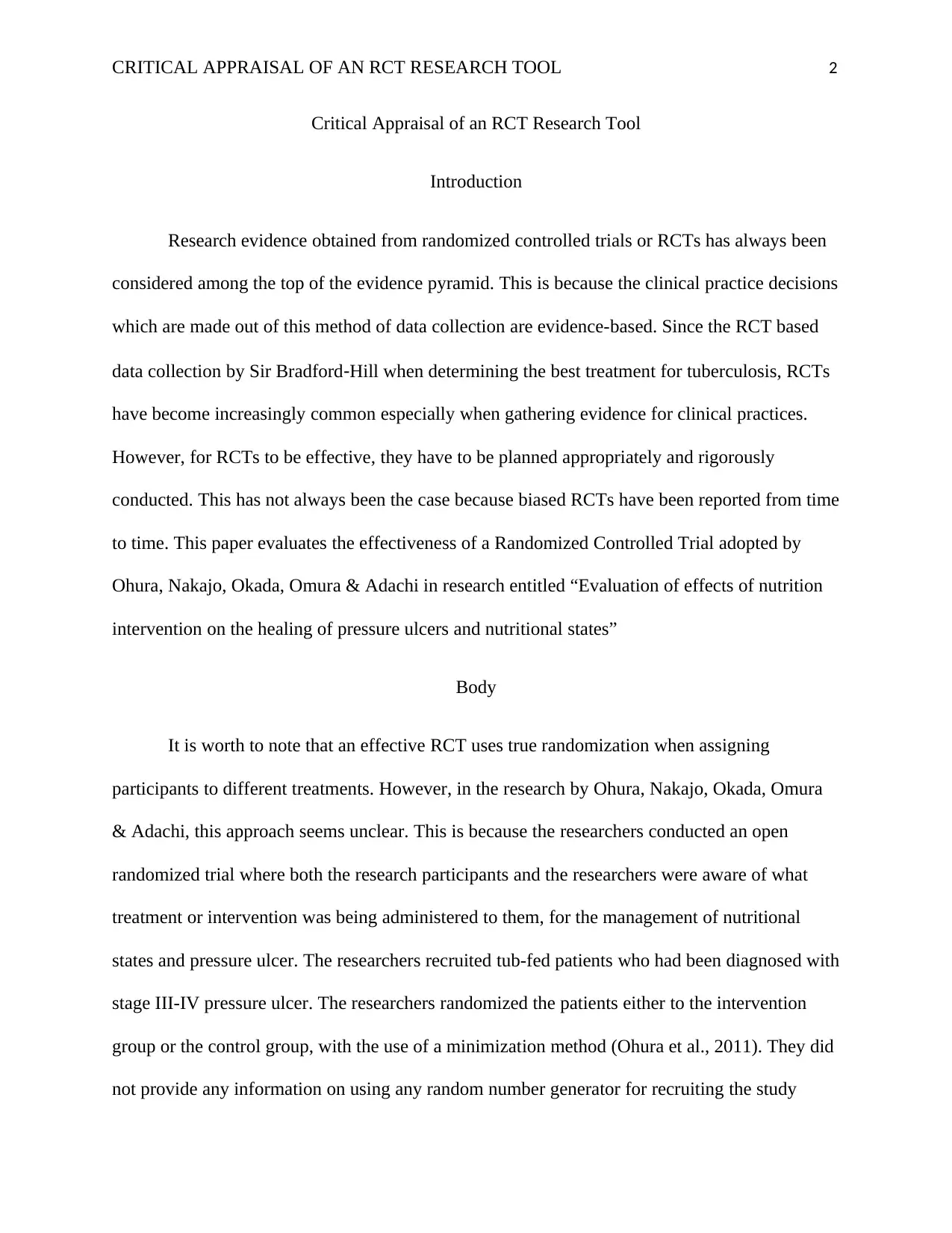
CRITICAL APPRAISAL OF AN RCT RESEARCH TOOL 2
Critical Appraisal of an RCT Research Tool
Introduction
Research evidence obtained from randomized controlled trials or RCTs has always been
considered among the top of the evidence pyramid. This is because the clinical practice decisions
which are made out of this method of data collection are evidence-based. Since the RCT based
data collection by Sir Bradford‐Hill when determining the best treatment for tuberculosis, RCTs
have become increasingly common especially when gathering evidence for clinical practices.
However, for RCTs to be effective, they have to be planned appropriately and rigorously
conducted. This has not always been the case because biased RCTs have been reported from time
to time. This paper evaluates the effectiveness of a Randomized Controlled Trial adopted by
Ohura, Nakajo, Okada, Omura & Adachi in research entitled “Evaluation of effects of nutrition
intervention on the healing of pressure ulcers and nutritional states”
Body
It is worth to note that an effective RCT uses true randomization when assigning
participants to different treatments. However, in the research by Ohura, Nakajo, Okada, Omura
& Adachi, this approach seems unclear. This is because the researchers conducted an open
randomized trial where both the research participants and the researchers were aware of what
treatment or intervention was being administered to them, for the management of nutritional
states and pressure ulcer. The researchers recruited tub-fed patients who had been diagnosed with
stage III-IV pressure ulcer. The researchers randomized the patients either to the intervention
group or the control group, with the use of a minimization method (Ohura et al., 2011). They did
not provide any information on using any random number generator for recruiting the study
Critical Appraisal of an RCT Research Tool
Introduction
Research evidence obtained from randomized controlled trials or RCTs has always been
considered among the top of the evidence pyramid. This is because the clinical practice decisions
which are made out of this method of data collection are evidence-based. Since the RCT based
data collection by Sir Bradford‐Hill when determining the best treatment for tuberculosis, RCTs
have become increasingly common especially when gathering evidence for clinical practices.
However, for RCTs to be effective, they have to be planned appropriately and rigorously
conducted. This has not always been the case because biased RCTs have been reported from time
to time. This paper evaluates the effectiveness of a Randomized Controlled Trial adopted by
Ohura, Nakajo, Okada, Omura & Adachi in research entitled “Evaluation of effects of nutrition
intervention on the healing of pressure ulcers and nutritional states”
Body
It is worth to note that an effective RCT uses true randomization when assigning
participants to different treatments. However, in the research by Ohura, Nakajo, Okada, Omura
& Adachi, this approach seems unclear. This is because the researchers conducted an open
randomized trial where both the research participants and the researchers were aware of what
treatment or intervention was being administered to them, for the management of nutritional
states and pressure ulcer. The researchers recruited tub-fed patients who had been diagnosed with
stage III-IV pressure ulcer. The researchers randomized the patients either to the intervention
group or the control group, with the use of a minimization method (Ohura et al., 2011). They did
not provide any information on using any random number generator for recruiting the study
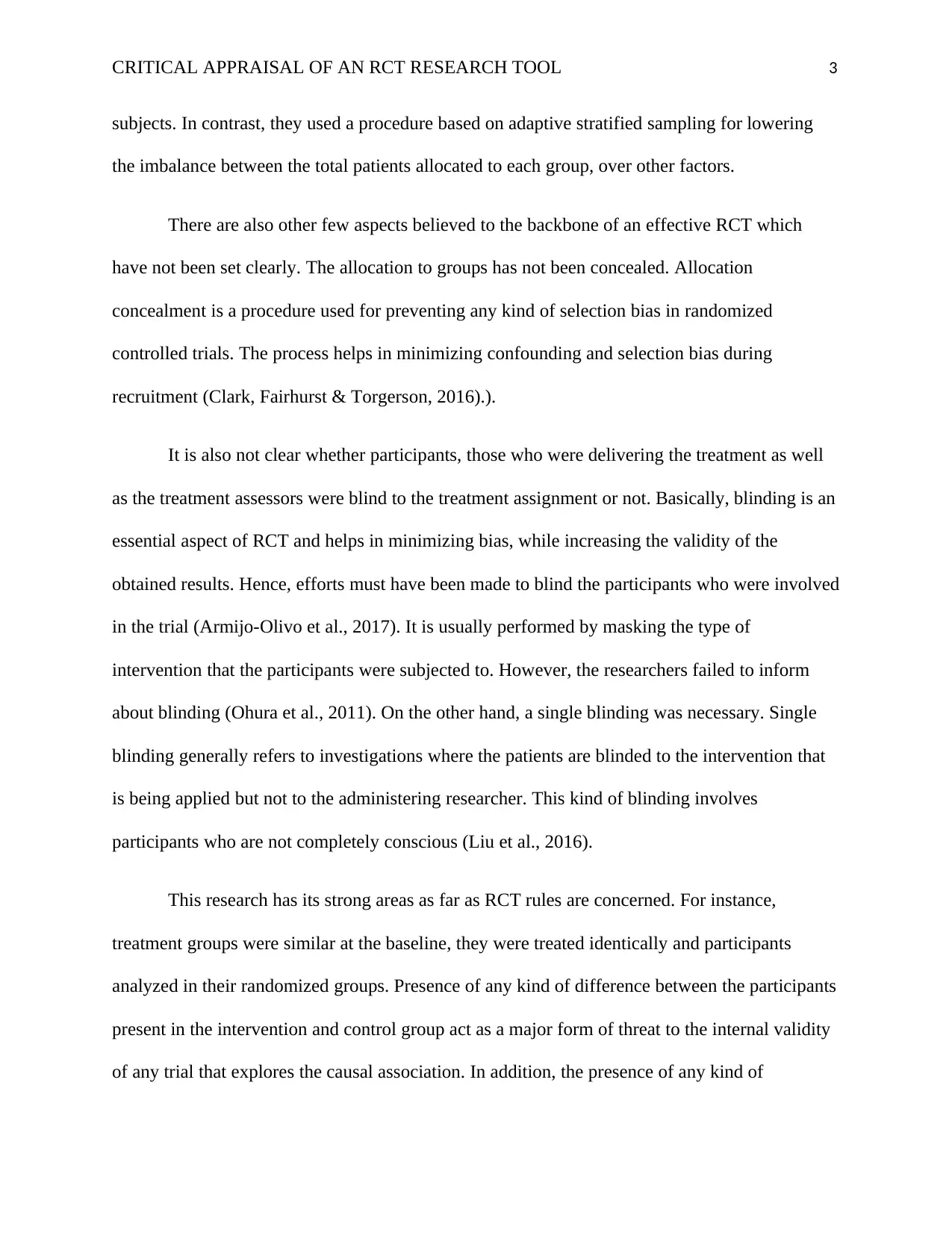
CRITICAL APPRAISAL OF AN RCT RESEARCH TOOL 3
subjects. In contrast, they used a procedure based on adaptive stratified sampling for lowering
the imbalance between the total patients allocated to each group, over other factors.
There are also other few aspects believed to the backbone of an effective RCT which
have not been set clearly. The allocation to groups has not been concealed. Allocation
concealment is a procedure used for preventing any kind of selection bias in randomized
controlled trials. The process helps in minimizing confounding and selection bias during
recruitment (Clark, Fairhurst & Torgerson, 2016).).
It is also not clear whether participants, those who were delivering the treatment as well
as the treatment assessors were blind to the treatment assignment or not. Basically, blinding is an
essential aspect of RCT and helps in minimizing bias, while increasing the validity of the
obtained results. Hence, efforts must have been made to blind the participants who were involved
in the trial (Armijo-Olivo et al., 2017). It is usually performed by masking the type of
intervention that the participants were subjected to. However, the researchers failed to inform
about blinding (Ohura et al., 2011). On the other hand, a single blinding was necessary. Single
blinding generally refers to investigations where the patients are blinded to the intervention that
is being applied but not to the administering researcher. This kind of blinding involves
participants who are not completely conscious (Liu et al., 2016).
This research has its strong areas as far as RCT rules are concerned. For instance,
treatment groups were similar at the baseline, they were treated identically and participants
analyzed in their randomized groups. Presence of any kind of difference between the participants
present in the intervention and control group act as a major form of threat to the internal validity
of any trial that explores the causal association. In addition, the presence of any kind of
subjects. In contrast, they used a procedure based on adaptive stratified sampling for lowering
the imbalance between the total patients allocated to each group, over other factors.
There are also other few aspects believed to the backbone of an effective RCT which
have not been set clearly. The allocation to groups has not been concealed. Allocation
concealment is a procedure used for preventing any kind of selection bias in randomized
controlled trials. The process helps in minimizing confounding and selection bias during
recruitment (Clark, Fairhurst & Torgerson, 2016).).
It is also not clear whether participants, those who were delivering the treatment as well
as the treatment assessors were blind to the treatment assignment or not. Basically, blinding is an
essential aspect of RCT and helps in minimizing bias, while increasing the validity of the
obtained results. Hence, efforts must have been made to blind the participants who were involved
in the trial (Armijo-Olivo et al., 2017). It is usually performed by masking the type of
intervention that the participants were subjected to. However, the researchers failed to inform
about blinding (Ohura et al., 2011). On the other hand, a single blinding was necessary. Single
blinding generally refers to investigations where the patients are blinded to the intervention that
is being applied but not to the administering researcher. This kind of blinding involves
participants who are not completely conscious (Liu et al., 2016).
This research has its strong areas as far as RCT rules are concerned. For instance,
treatment groups were similar at the baseline, they were treated identically and participants
analyzed in their randomized groups. Presence of any kind of difference between the participants
present in the intervention and control group act as a major form of threat to the internal validity
of any trial that explores the causal association. In addition, the presence of any kind of
⊘ This is a preview!⊘
Do you want full access?
Subscribe today to unlock all pages.

Trusted by 1+ million students worldwide
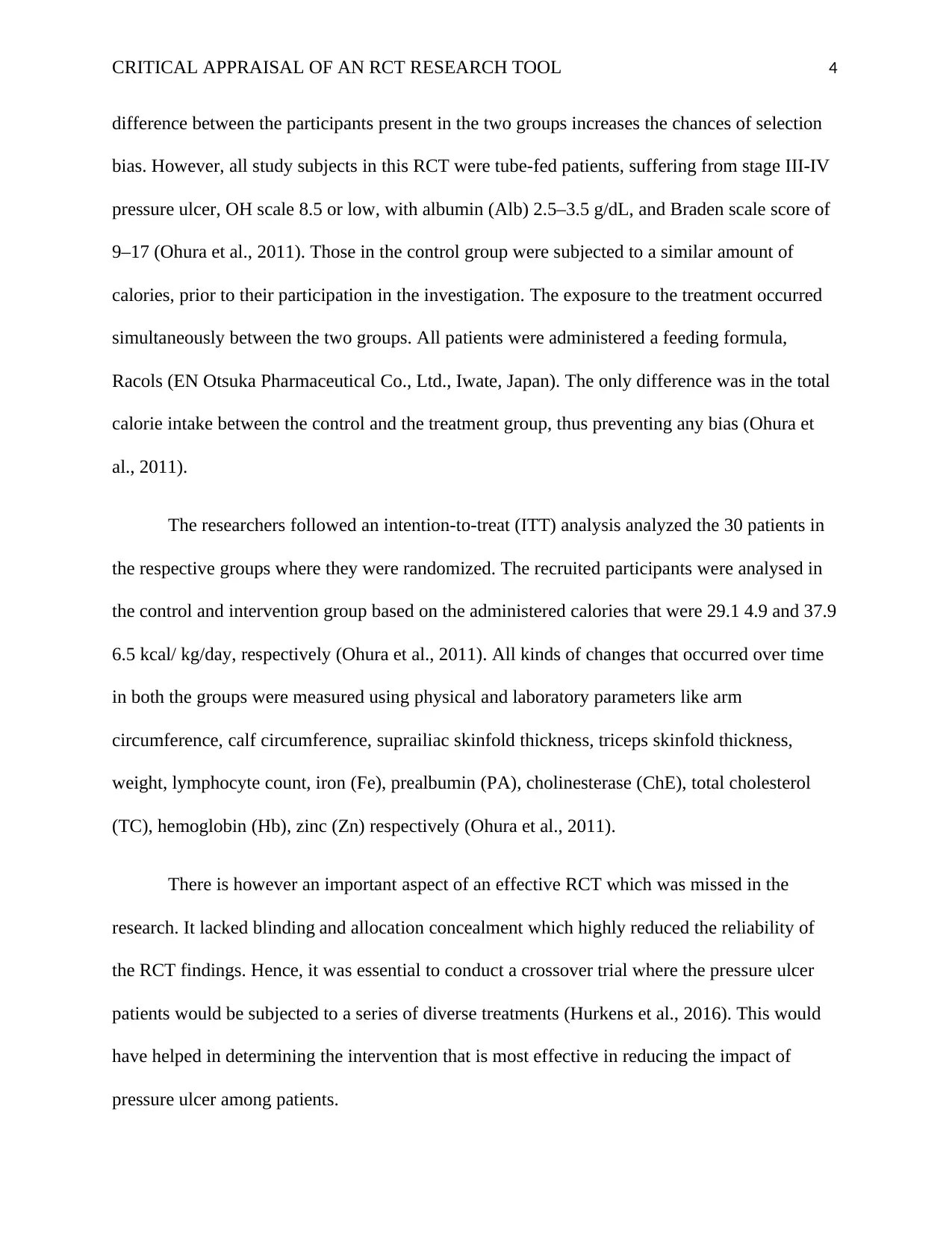
CRITICAL APPRAISAL OF AN RCT RESEARCH TOOL 4
difference between the participants present in the two groups increases the chances of selection
bias. However, all study subjects in this RCT were tube-fed patients, suffering from stage III-IV
pressure ulcer, OH scale 8.5 or low, with albumin (Alb) 2.5–3.5 g/dL, and Braden scale score of
9–17 (Ohura et al., 2011). Those in the control group were subjected to a similar amount of
calories, prior to their participation in the investigation. The exposure to the treatment occurred
simultaneously between the two groups. All patients were administered a feeding formula,
Racols (EN Otsuka Pharmaceutical Co., Ltd., Iwate, Japan). The only difference was in the total
calorie intake between the control and the treatment group, thus preventing any bias (Ohura et
al., 2011).
The researchers followed an intention-to-treat (ITT) analysis analyzed the 30 patients in
the respective groups where they were randomized. The recruited participants were analysed in
the control and intervention group based on the administered calories that were 29.1 4.9 and 37.9
6.5 kcal/ kg/day, respectively (Ohura et al., 2011). All kinds of changes that occurred over time
in both the groups were measured using physical and laboratory parameters like arm
circumference, calf circumference, suprailiac skinfold thickness, triceps skinfold thickness,
weight, lymphocyte count, iron (Fe), prealbumin (PA), cholinesterase (ChE), total cholesterol
(TC), hemoglobin (Hb), zinc (Zn) respectively (Ohura et al., 2011).
There is however an important aspect of an effective RCT which was missed in the
research. It lacked blinding and allocation concealment which highly reduced the reliability of
the RCT findings. Hence, it was essential to conduct a crossover trial where the pressure ulcer
patients would be subjected to a series of diverse treatments (Hurkens et al., 2016). This would
have helped in determining the intervention that is most effective in reducing the impact of
pressure ulcer among patients.
difference between the participants present in the two groups increases the chances of selection
bias. However, all study subjects in this RCT were tube-fed patients, suffering from stage III-IV
pressure ulcer, OH scale 8.5 or low, with albumin (Alb) 2.5–3.5 g/dL, and Braden scale score of
9–17 (Ohura et al., 2011). Those in the control group were subjected to a similar amount of
calories, prior to their participation in the investigation. The exposure to the treatment occurred
simultaneously between the two groups. All patients were administered a feeding formula,
Racols (EN Otsuka Pharmaceutical Co., Ltd., Iwate, Japan). The only difference was in the total
calorie intake between the control and the treatment group, thus preventing any bias (Ohura et
al., 2011).
The researchers followed an intention-to-treat (ITT) analysis analyzed the 30 patients in
the respective groups where they were randomized. The recruited participants were analysed in
the control and intervention group based on the administered calories that were 29.1 4.9 and 37.9
6.5 kcal/ kg/day, respectively (Ohura et al., 2011). All kinds of changes that occurred over time
in both the groups were measured using physical and laboratory parameters like arm
circumference, calf circumference, suprailiac skinfold thickness, triceps skinfold thickness,
weight, lymphocyte count, iron (Fe), prealbumin (PA), cholinesterase (ChE), total cholesterol
(TC), hemoglobin (Hb), zinc (Zn) respectively (Ohura et al., 2011).
There is however an important aspect of an effective RCT which was missed in the
research. It lacked blinding and allocation concealment which highly reduced the reliability of
the RCT findings. Hence, it was essential to conduct a crossover trial where the pressure ulcer
patients would be subjected to a series of diverse treatments (Hurkens et al., 2016). This would
have helped in determining the intervention that is most effective in reducing the impact of
pressure ulcer among patients.
Paraphrase This Document
Need a fresh take? Get an instant paraphrase of this document with our AI Paraphraser
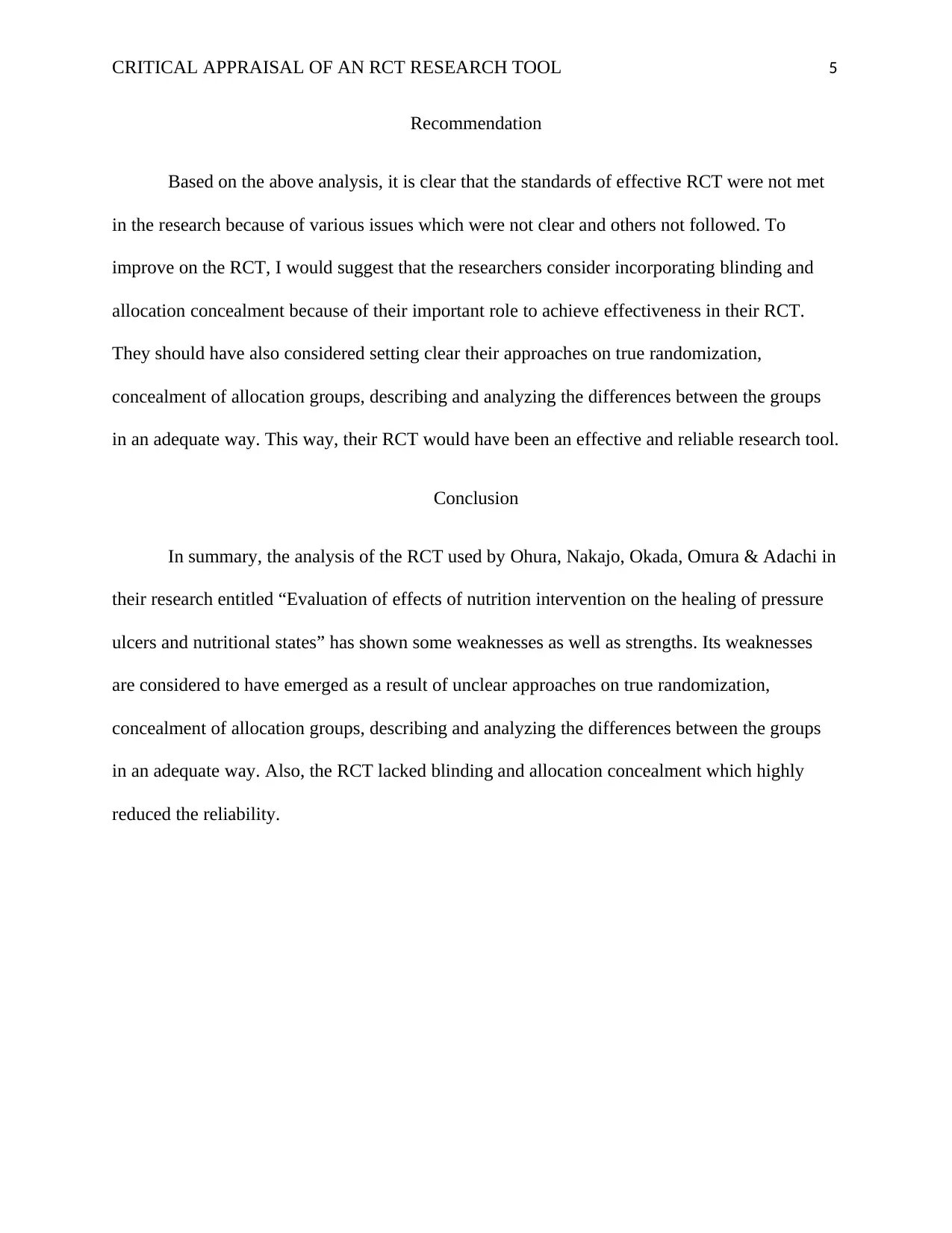
CRITICAL APPRAISAL OF AN RCT RESEARCH TOOL 5
Recommendation
Based on the above analysis, it is clear that the standards of effective RCT were not met
in the research because of various issues which were not clear and others not followed. To
improve on the RCT, I would suggest that the researchers consider incorporating blinding and
allocation concealment because of their important role to achieve effectiveness in their RCT.
They should have also considered setting clear their approaches on true randomization,
concealment of allocation groups, describing and analyzing the differences between the groups
in an adequate way. This way, their RCT would have been an effective and reliable research tool.
Conclusion
In summary, the analysis of the RCT used by Ohura, Nakajo, Okada, Omura & Adachi in
their research entitled “Evaluation of effects of nutrition intervention on the healing of pressure
ulcers and nutritional states” has shown some weaknesses as well as strengths. Its weaknesses
are considered to have emerged as a result of unclear approaches on true randomization,
concealment of allocation groups, describing and analyzing the differences between the groups
in an adequate way. Also, the RCT lacked blinding and allocation concealment which highly
reduced the reliability.
Recommendation
Based on the above analysis, it is clear that the standards of effective RCT were not met
in the research because of various issues which were not clear and others not followed. To
improve on the RCT, I would suggest that the researchers consider incorporating blinding and
allocation concealment because of their important role to achieve effectiveness in their RCT.
They should have also considered setting clear their approaches on true randomization,
concealment of allocation groups, describing and analyzing the differences between the groups
in an adequate way. This way, their RCT would have been an effective and reliable research tool.
Conclusion
In summary, the analysis of the RCT used by Ohura, Nakajo, Okada, Omura & Adachi in
their research entitled “Evaluation of effects of nutrition intervention on the healing of pressure
ulcers and nutritional states” has shown some weaknesses as well as strengths. Its weaknesses
are considered to have emerged as a result of unclear approaches on true randomization,
concealment of allocation groups, describing and analyzing the differences between the groups
in an adequate way. Also, the RCT lacked blinding and allocation concealment which highly
reduced the reliability.
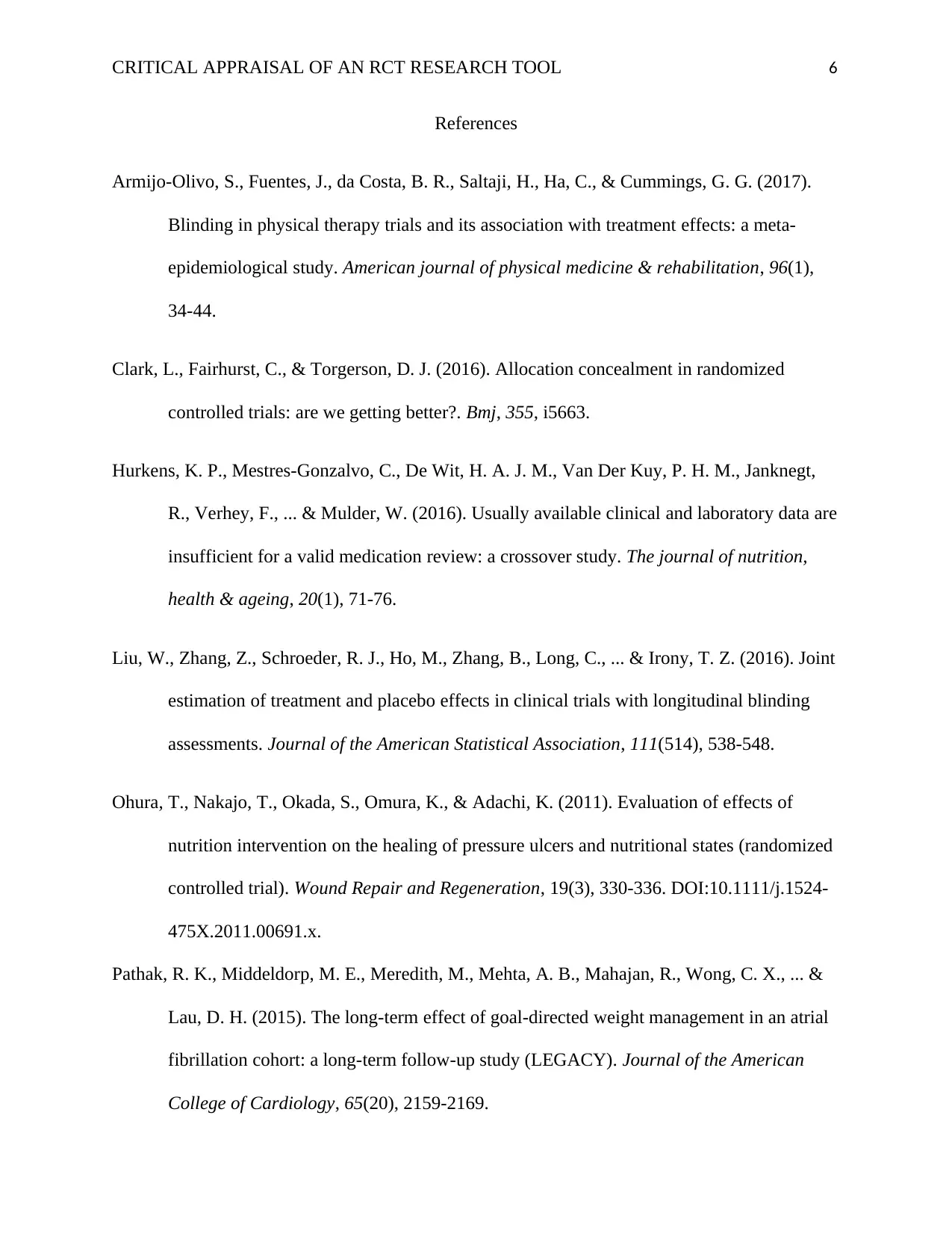
CRITICAL APPRAISAL OF AN RCT RESEARCH TOOL 6
References
Armijo-Olivo, S., Fuentes, J., da Costa, B. R., Saltaji, H., Ha, C., & Cummings, G. G. (2017).
Blinding in physical therapy trials and its association with treatment effects: a meta-
epidemiological study. American journal of physical medicine & rehabilitation, 96(1),
34-44.
Clark, L., Fairhurst, C., & Torgerson, D. J. (2016). Allocation concealment in randomized
controlled trials: are we getting better?. Bmj, 355, i5663.
Hurkens, K. P., Mestres-Gonzalvo, C., De Wit, H. A. J. M., Van Der Kuy, P. H. M., Janknegt,
R., Verhey, F., ... & Mulder, W. (2016). Usually available clinical and laboratory data are
insufficient for a valid medication review: a crossover study. The journal of nutrition,
health & ageing, 20(1), 71-76.
Liu, W., Zhang, Z., Schroeder, R. J., Ho, M., Zhang, B., Long, C., ... & Irony, T. Z. (2016). Joint
estimation of treatment and placebo effects in clinical trials with longitudinal blinding
assessments. Journal of the American Statistical Association, 111(514), 538-548.
Ohura, T., Nakajo, T., Okada, S., Omura, K., & Adachi, K. (2011). Evaluation of effects of
nutrition intervention on the healing of pressure ulcers and nutritional states (randomized
controlled trial). Wound Repair and Regeneration, 19(3), 330-336. DOI:10.1111/j.1524-
475X.2011.00691.x.
Pathak, R. K., Middeldorp, M. E., Meredith, M., Mehta, A. B., Mahajan, R., Wong, C. X., ... &
Lau, D. H. (2015). The long-term effect of goal-directed weight management in an atrial
fibrillation cohort: a long-term follow-up study (LEGACY). Journal of the American
College of Cardiology, 65(20), 2159-2169.
References
Armijo-Olivo, S., Fuentes, J., da Costa, B. R., Saltaji, H., Ha, C., & Cummings, G. G. (2017).
Blinding in physical therapy trials and its association with treatment effects: a meta-
epidemiological study. American journal of physical medicine & rehabilitation, 96(1),
34-44.
Clark, L., Fairhurst, C., & Torgerson, D. J. (2016). Allocation concealment in randomized
controlled trials: are we getting better?. Bmj, 355, i5663.
Hurkens, K. P., Mestres-Gonzalvo, C., De Wit, H. A. J. M., Van Der Kuy, P. H. M., Janknegt,
R., Verhey, F., ... & Mulder, W. (2016). Usually available clinical and laboratory data are
insufficient for a valid medication review: a crossover study. The journal of nutrition,
health & ageing, 20(1), 71-76.
Liu, W., Zhang, Z., Schroeder, R. J., Ho, M., Zhang, B., Long, C., ... & Irony, T. Z. (2016). Joint
estimation of treatment and placebo effects in clinical trials with longitudinal blinding
assessments. Journal of the American Statistical Association, 111(514), 538-548.
Ohura, T., Nakajo, T., Okada, S., Omura, K., & Adachi, K. (2011). Evaluation of effects of
nutrition intervention on the healing of pressure ulcers and nutritional states (randomized
controlled trial). Wound Repair and Regeneration, 19(3), 330-336. DOI:10.1111/j.1524-
475X.2011.00691.x.
Pathak, R. K., Middeldorp, M. E., Meredith, M., Mehta, A. B., Mahajan, R., Wong, C. X., ... &
Lau, D. H. (2015). The long-term effect of goal-directed weight management in an atrial
fibrillation cohort: a long-term follow-up study (LEGACY). Journal of the American
College of Cardiology, 65(20), 2159-2169.
⊘ This is a preview!⊘
Do you want full access?
Subscribe today to unlock all pages.

Trusted by 1+ million students worldwide
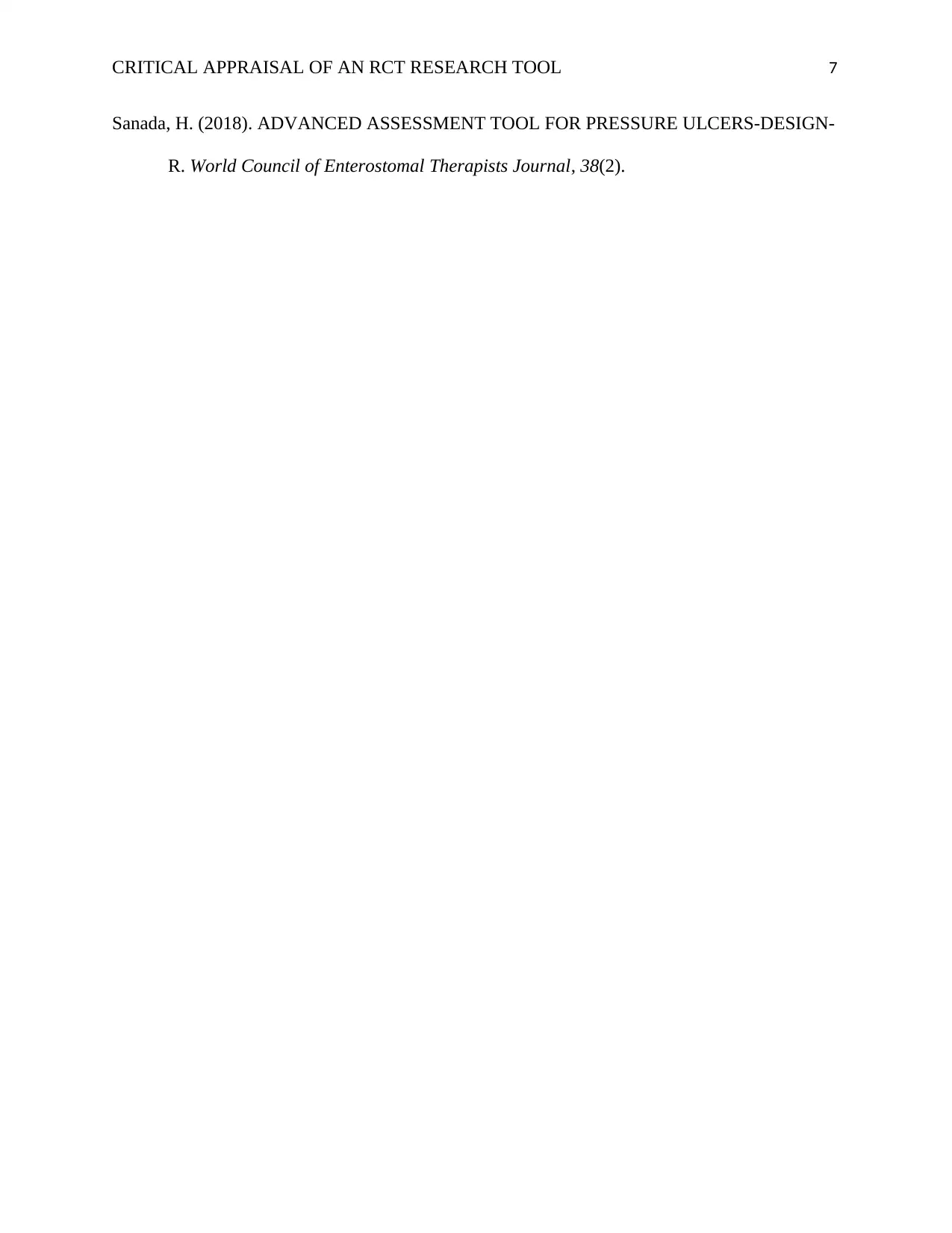
CRITICAL APPRAISAL OF AN RCT RESEARCH TOOL 7
Sanada, H. (2018). ADVANCED ASSESSMENT TOOL FOR PRESSURE ULCERS-DESIGN-
R. World Council of Enterostomal Therapists Journal, 38(2).
Sanada, H. (2018). ADVANCED ASSESSMENT TOOL FOR PRESSURE ULCERS-DESIGN-
R. World Council of Enterostomal Therapists Journal, 38(2).
1 out of 7
Related Documents
Your All-in-One AI-Powered Toolkit for Academic Success.
+13062052269
info@desklib.com
Available 24*7 on WhatsApp / Email
![[object Object]](/_next/static/media/star-bottom.7253800d.svg)
Unlock your academic potential
Copyright © 2020–2025 A2Z Services. All Rights Reserved. Developed and managed by ZUCOL.





